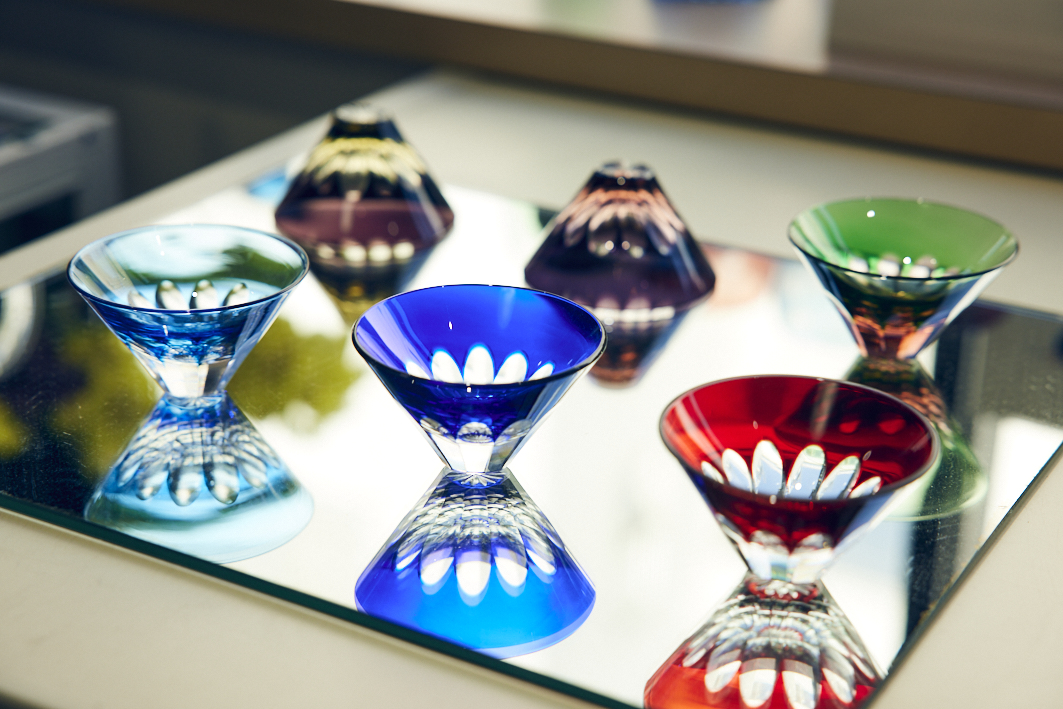Edogawa Craft Stories

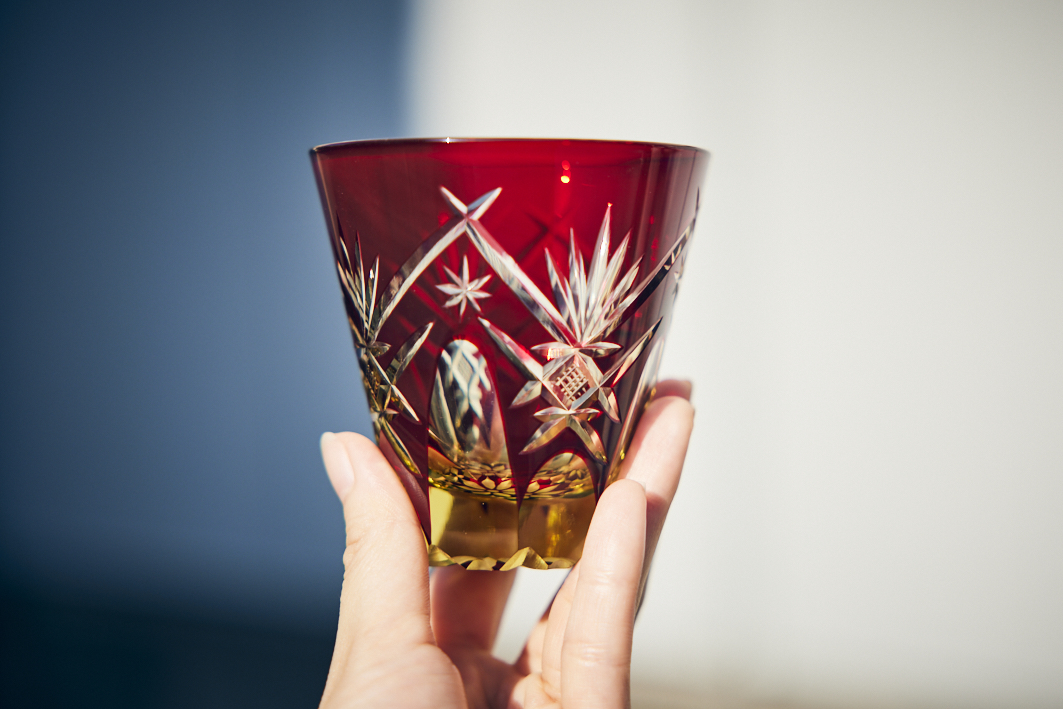
Adding Sparkle to Everyday Life: The Beauty of Layered, Colored Edo Glassware
Nakakin Glass
Nakamura Hiroko and Iwabuchi Michiko
Deep reds and blues, rich in color yet full of transparency. Soft, gentle shades of yellow and light blue. The vivid light reflected by the cut-glass tumblers—etched with delicate floral and auspicious patterns—immediately draws the eye.
“They’re beautiful, aren’t they?” says Nakamura Hiroko with a smile. “Our glass has always been known for its color. That’s something we’ve been proud of from the beginning.”
The workshop is located in Hirai, a district in Tokyo’s Edogawa City with views of the towering Tokyo Skytree. It was here, in 1946, that Nakakin Glass was founded. From melting and blowing glass to shaping and finishing, the company has always handled every part of the process in-house. While drawing on the traditions of Edo glass, which date back to the Edo period, the team continues to innovate through independent research and development, crafting a wide range of original products in the process.
When people hear “Edo glass,” they often think of Edo kiriko, but technically, kiriko refers to Edo glass that has been engraved with decorative patterns. At Nakakin, it’s the base material, the Edo glass itself, that’s made on-site in Edogawa.
Among the company’s signature techniques is irogise glass, or layered colored glass, produced by blowing together two layers of colored glass. Known for its vibrant hues, this technique has earned the company lasting recognition. But what’s the secret behind its distinctive glow?
“Layered colored glass originally came from Europe. Traditionally, the process involves first blowing and shaping colored glass, then reheating it and layering another color on top. But what our founder, Nakamura Kingo, developed was something different,” explains Hiroko. “He came up with a method where you first blow a paper-thin layer of colored glass, and while it’s still hot, you blow a layer of clear glass inside it, bonding them together. That technique creates a vivid contrast between the color and the transparency—and that’s what makes our glass stand out.”
This unique method became known as the Pokan technique, named after the popping sound the glass makes when it’s removed from the furnace. The name stuck, and the method became widely recognized even among other glassmakers.
The company’s Nakakin irogise glass has also breathed new life into the world of Edo kiriko, one of Tokyo’s most iconic traditional crafts. Kiriko—typically cut and polished from clear, transparent glass—gained new expressive possibilities with the introduction of Nakakin’s vividly colored base material.
“Some kiriko artisans now use our irogise glass, and they tell us not only that the color is beautiful, but also that the glass is softer and more elastic, which makes it easier to cut and work with,” Hiroko says. “We’ve only ever worked with our own glass, so we don’t really know the difference—but it’s lovely to hear.”
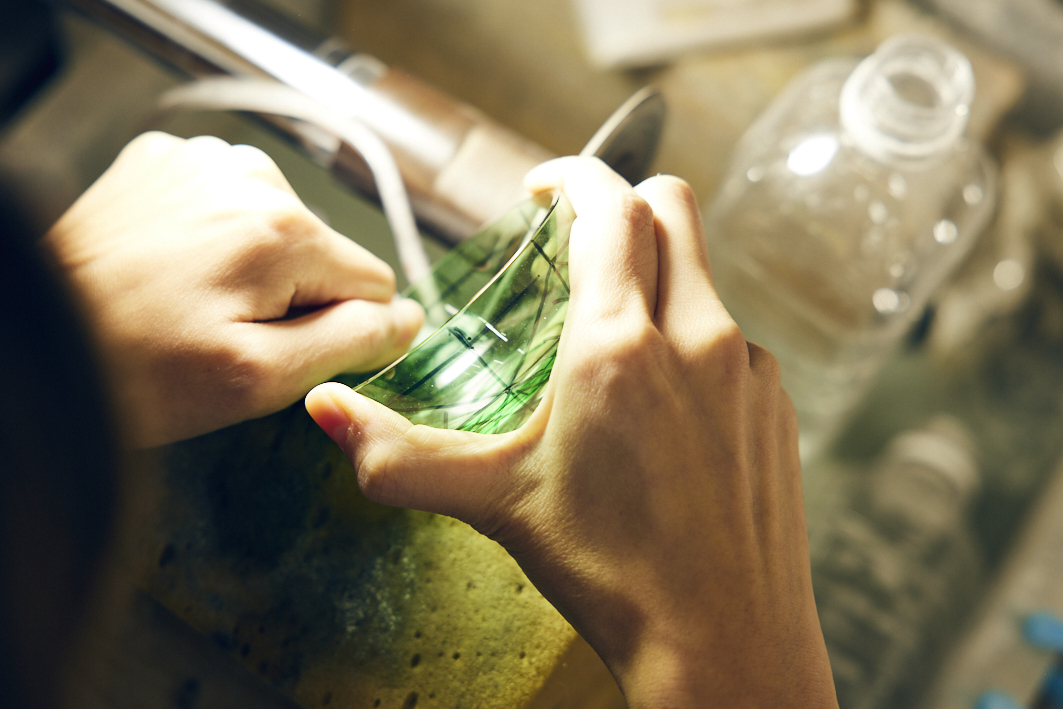
The kiriko cutting process is delicate and highly detailed. The force used must be adjusted precisely depending on the width, shape, and depth of each cut.
At the Nakakin workshop, the glass melting and shaping is handled by Nakamura Seigo, Hiroko’s son and the third-generation successor, along with Iwabuchi Jun, the husband of Hiroko’s daughter Michiko. Both also work on the kiriko finishing process. Once the shaping is complete, Hiroko and Michiko join in for the final stages. The two women are also responsible for designing many of the company’s products.
“Melting the glass is actually one of the hardest parts,” says Michiko. “You have to melt silica sand at 1,400 degrees Celsius and bring it to the perfect state for shaping. That’s where the real challenge is. Colored glass is especially tricky—you need it to be vibrant, but also easy to carve for kiriko work. Temperature control is everything, and you also need a trained eye and experience to judge the timing. My brother and my husband take turns watching over the melting process at night. They’re the quiet workhorses behind it all.”
Michiko grew up watching her parents carry out every step of the glassmaking process. After graduating from junior college, she worked outside the family business for a few years.
“I always loved what my parents did, so I helped out whenever I could. I thought maybe I could stay involved while still doing another job on the side. But before I knew it, my husband had become a craftsman too!” she laughs. “Eventually, I realized I wanted to do this full-time. To be honest, I felt this sense of urgency—like if we stopped, the technique would disappear. I felt a responsibility not to let that happen.”
Her husband, Jun, became interested in glassmaking after marrying into the family. At first, he helped out around the workshop, but gradually, he found his calling—and is now fully immersed in the work.
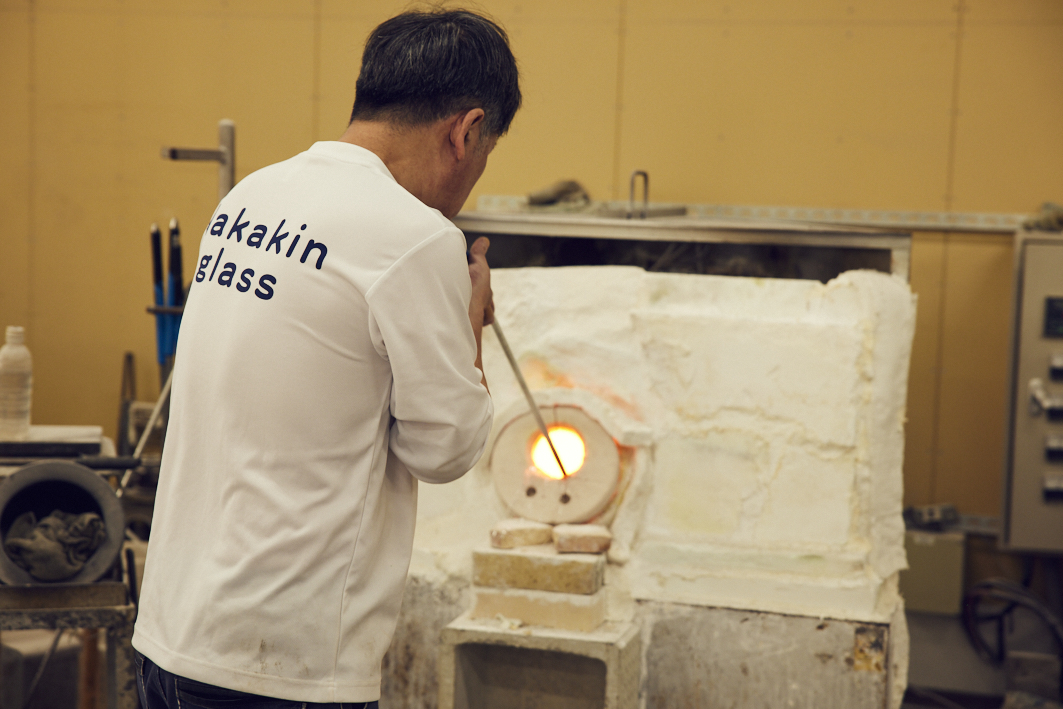
Iwabuchi Jun melts clear glass in a furnace heated to 1,400°C. In summer, it’s like being in a sauna.
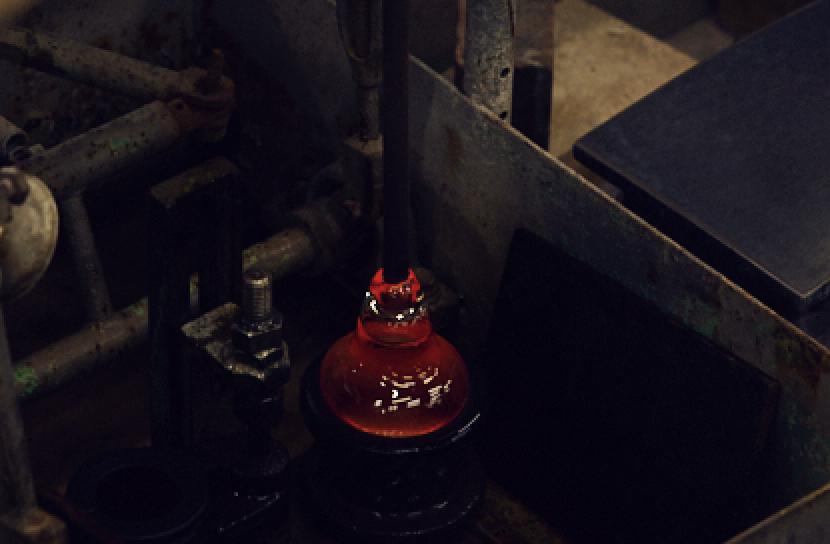
Fresh from the furnace, the molten glass is swiftly shaped by blowing air into it while it’s still glowing hot.
Hiroko, who married into the Nakamura family, began working in the business in 1984. Nearly 40 years later, she still finds joy in every part of the process. “I’ve never once thought about quitting or found the work too hard. I’m always wondering, ‘What else can we do with this glass? Can we bring out new colors?’ I never stop getting excited about it.”
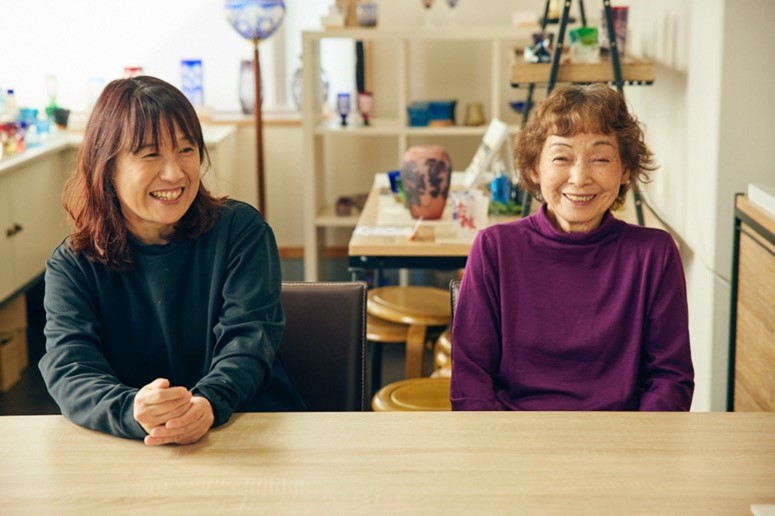
Nakamura Hiroko (right), who says, “I just can’t get enough of making glassware,” with her daughter Iwabuchi Michiko, who supports her every step of the way.
One of Hiroko’s signature creations is the Guinomi Sakasa Fuji series. These cut-glass sake cups reveal a firework motif when viewed from above, and when turned upside down, take the shape of Mount Fuji.
“I created this series in 2013, the year Mount Fuji was designated a World Cultural Heritage site. It started with the idea of capturing that iconic, sweeping silhouette of the mountain’s base.”
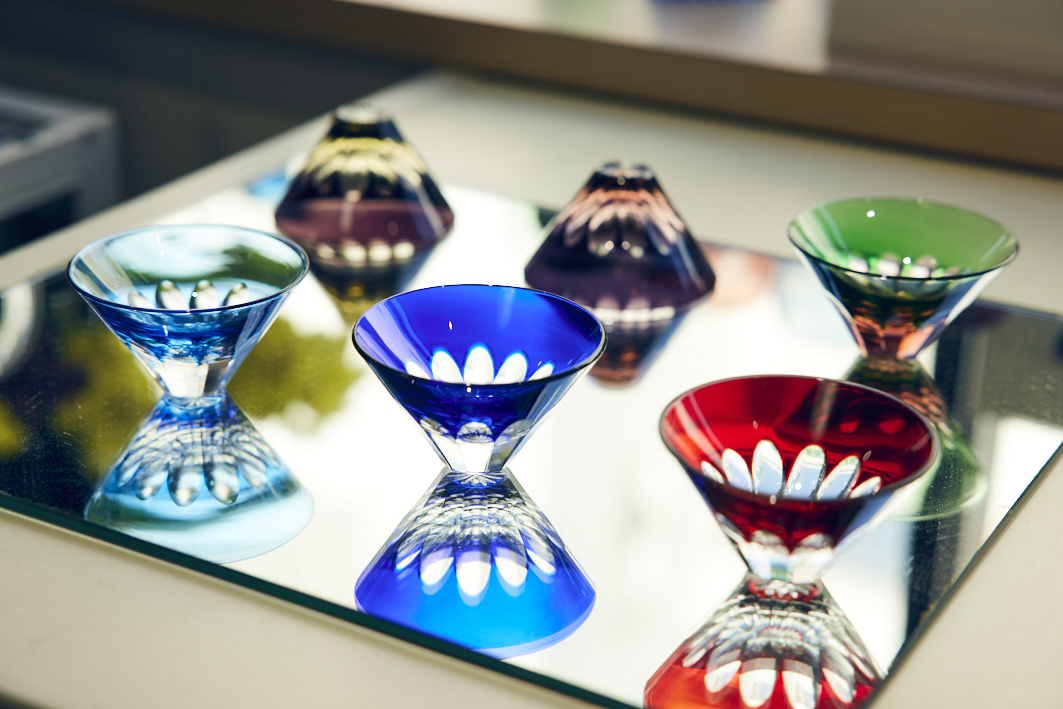
From above, a firework pattern; upside down, the shape of Mount Fuji — Nakakin Ikisai Kiriko Guinomi Sakasa Fuji.
Meanwhile, Iwabuchi Michiko has been releasing product after product focused on the beauty of glass as it interacts with light. One example is the Asagao Lamp, a portable cut-glass lamp designed not only to be beautiful in itself, but also to cast mesmerizing reflections on walls and ceilings.
“I hope people can enjoy moments of calm at home, soaking in the gentle reflections and shimmering light that only glass can create. Along similar lines, I also collaborated with a designer to make the EDO AQUA GLASS, a vessel for hydroponic cultivation. It’s both decorative and functional—you can grow plants while enjoying the shadows and light it creates.”
Made using blown-glass techniques, and further embellished with kiriko or sandblasted patterns, the EDO AQUA GLASS comes in four varieties, including a dotted crimson version, a soft sky blue, and a crystal-clear type that highlights transparency. Each one is crafted with a deep sensitivity to how light and water interplay through the glass.
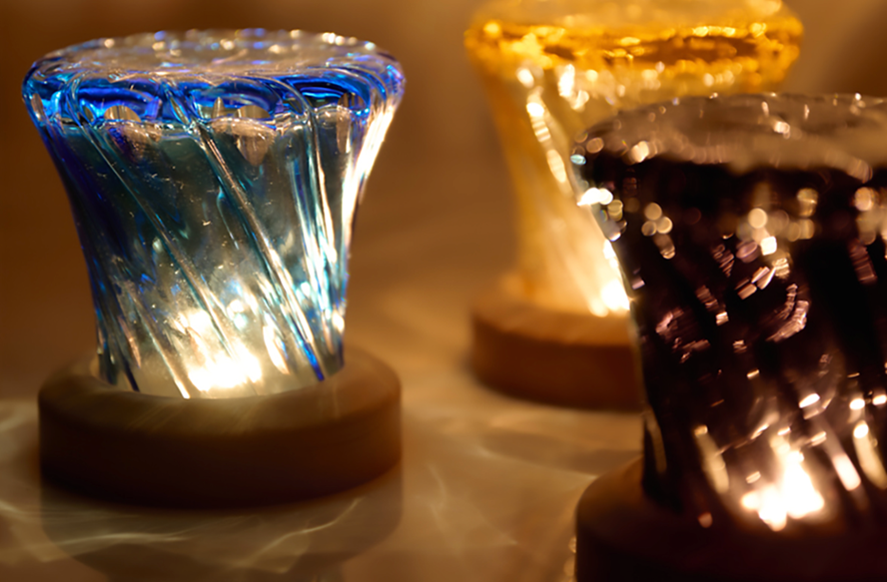
The Asagao Lamp combines handcrafted glass with kiriko techniques to create soft, ambient light—perfect for relaxing moments.
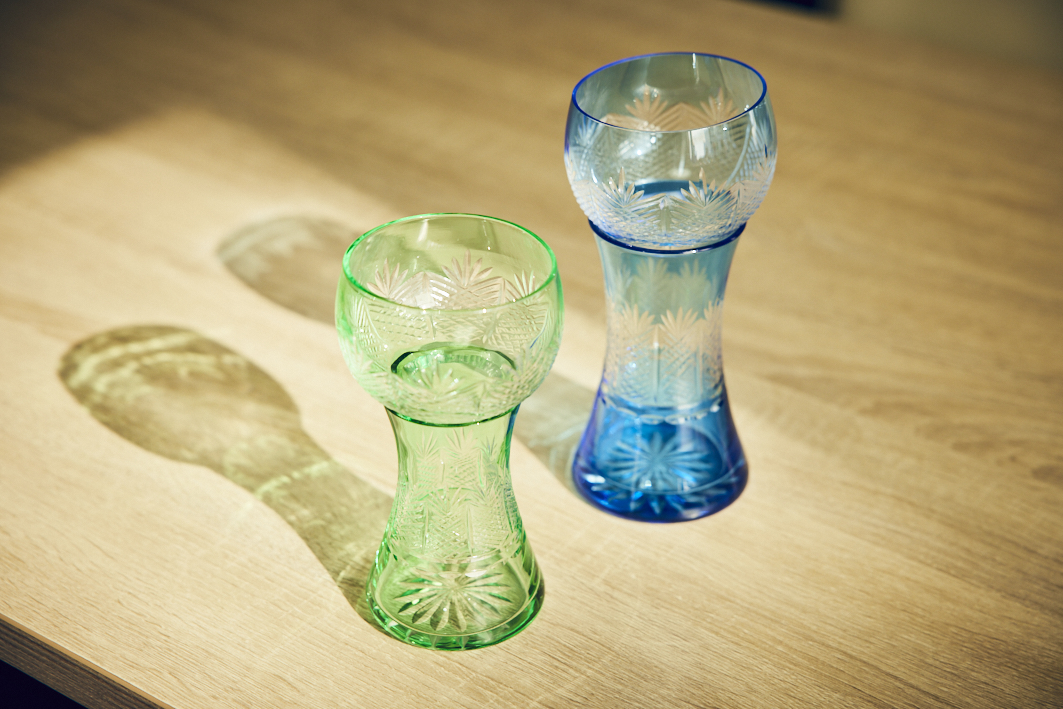
With striking transparency and colorful gradients, the EDO AQUA GLASS offers not just visual delight, but also a new way to enjoy hydroponics and flower arranging through traditional craftsmanship.
“These days, I feel like people really crave transparency in glass,” says Michiko. “Up to now, we’ve focused on rich, vivid colors, but we’re experimenting with creating gentler, softer tones as well. Still, I have a particular fondness for our deep red glass. It’s actually the hardest color to produce. Even slight changes in temperature can ruin it, and I know both my grandfather and my father struggled with it plenty. Looking back, I’m truly grateful they never gave up.”
Nakakin Glass currently offers 13 color pairings, including tosuki (clear red), toai (clear blue), kinfuji (golden wisteria), kinsora (golden sky), sakurafuji (cherry blossom wisteria), and sakuramidori (cherry blossom green). Each name evokes the elegance of Edo tradition blended with a contemporary flair.
In addition to their core work, Nakakin Glass has also been active in collaborative efforts, partnering with art university students in industry, academia, and public projects, and working with both the Tokyo Metropolitan Government and Edogawa City to explore new design possibilities.
“In the 2022 industry-academia-public project, I was so inspired by a student’s bold idea for a coffee dripper,” says Hiroko. “It’s heartening to see young people taking an interest in the unique properties of glass. Their fresh perspectives keep us energized too.” And Hiroko’s desire to innovate doesn’t stop there.
“Stained glass. I think it’s one of the most beautiful ways to experience the magic of light through glass. Of course, it would involve totally different materials and equipment from what we use now, but since we already have such a rich palette of colors, I’d really like to take that on someday.”
With one hand on tradition and the other reaching toward innovation, Nakakin Glass continues to chart a vibrant future for Edo glass.
Photos: Honna Yuka
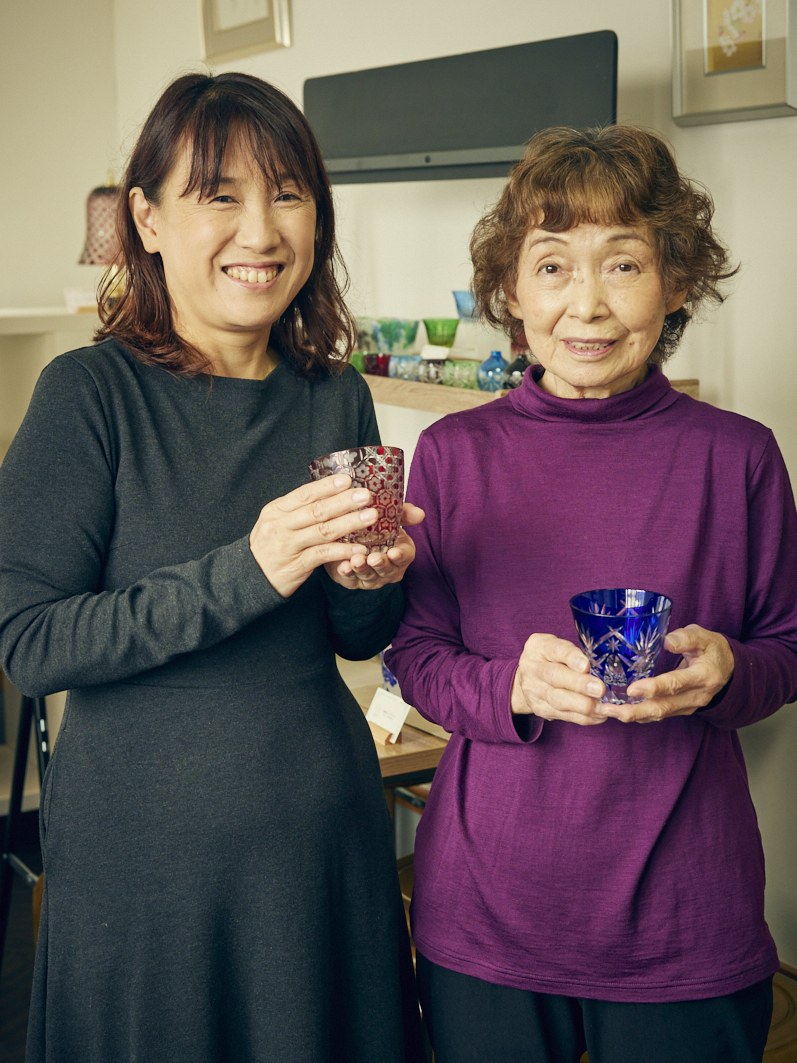
Introduction of the Artisan
Established in 1946, Nakakin Glass specializes in the production of Nakakin Irokise glass, made by layering two colors of glass and blowing them together. The company has been committed to popularizing Edo glass since its inception and also sells original Kiriko cut- glass products from a store adjacent to their workshop. As their primary focus is manufacturing, shop visits require prior reservation.
・Nakakin Glass
・2-11-29 Hirai, Edogawa-ku, Tokyo
